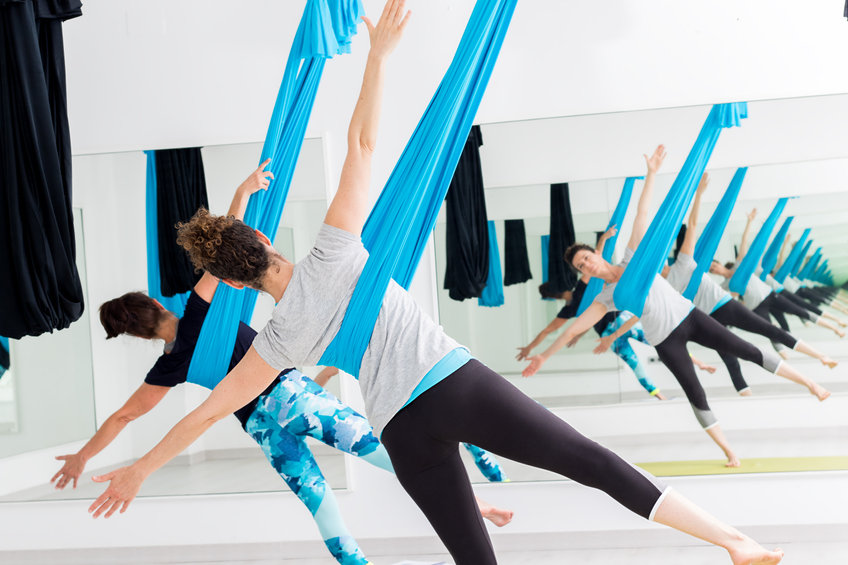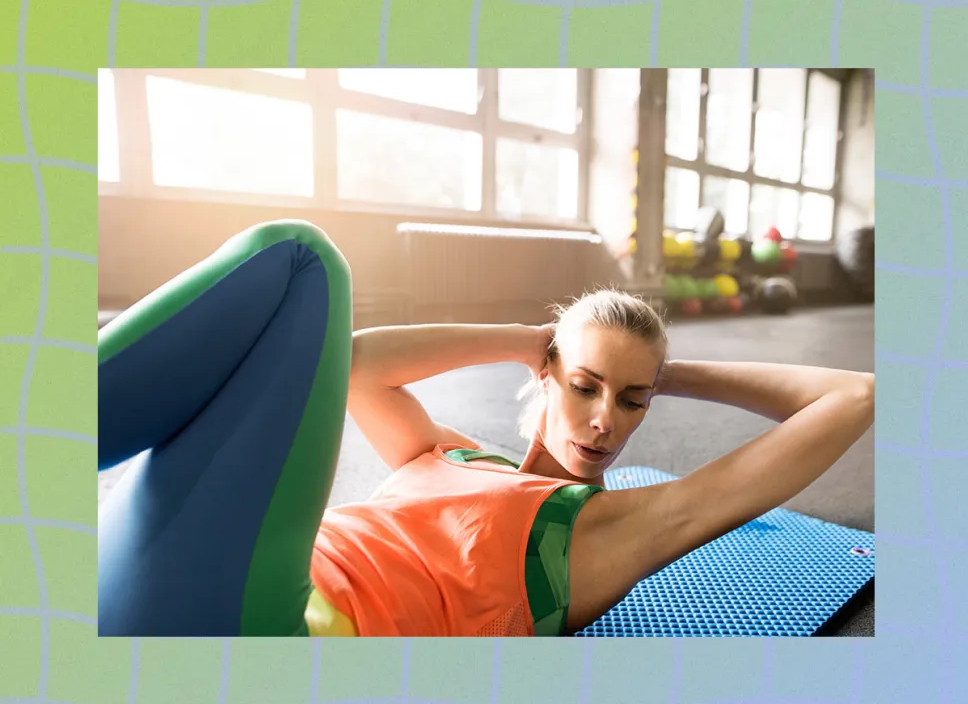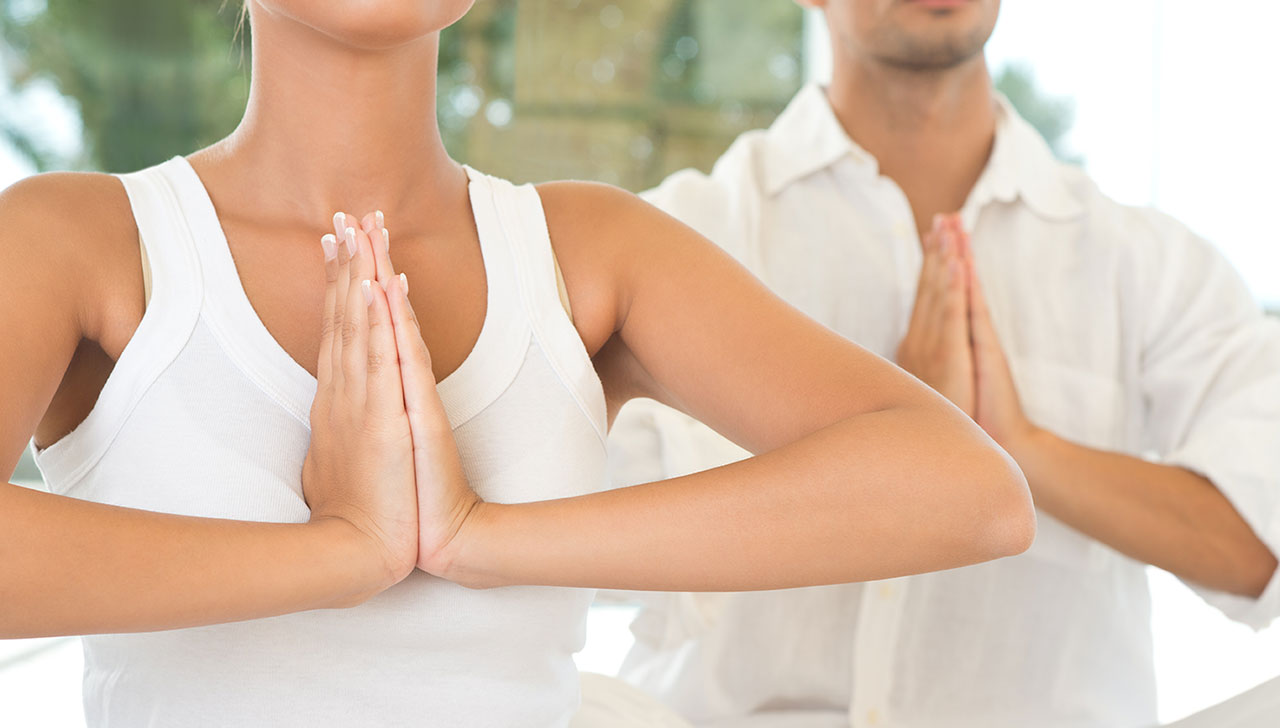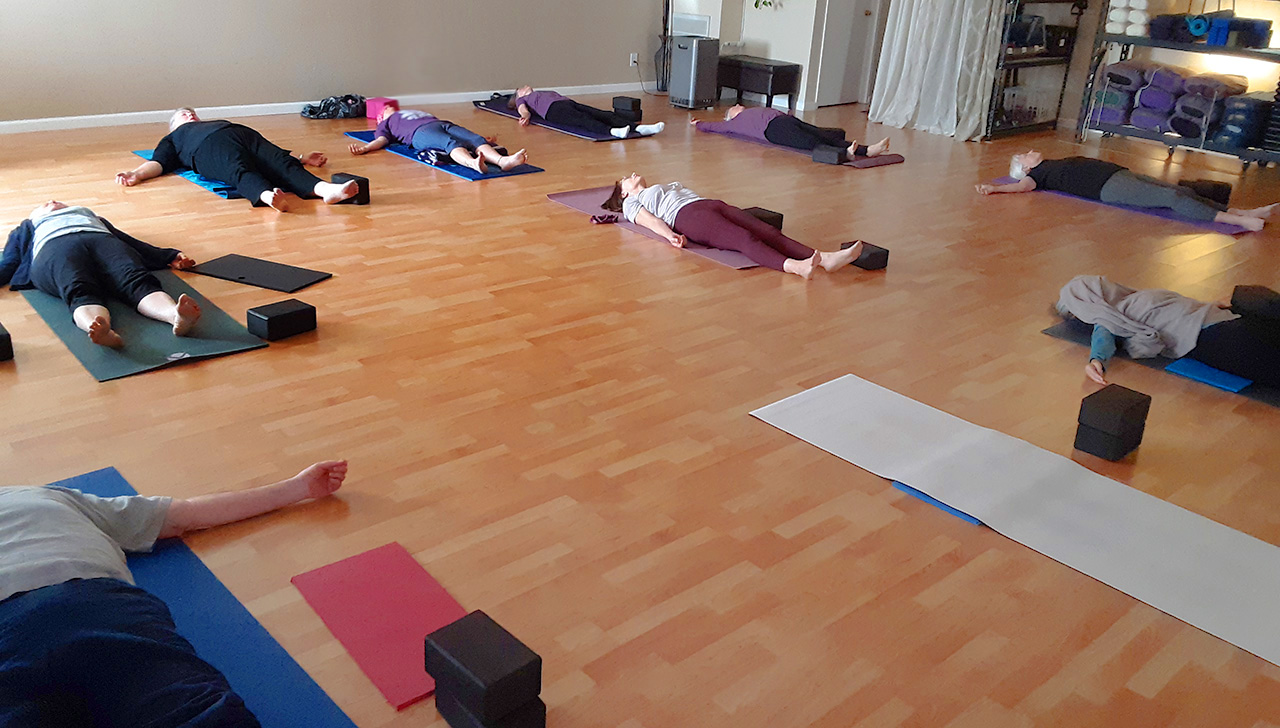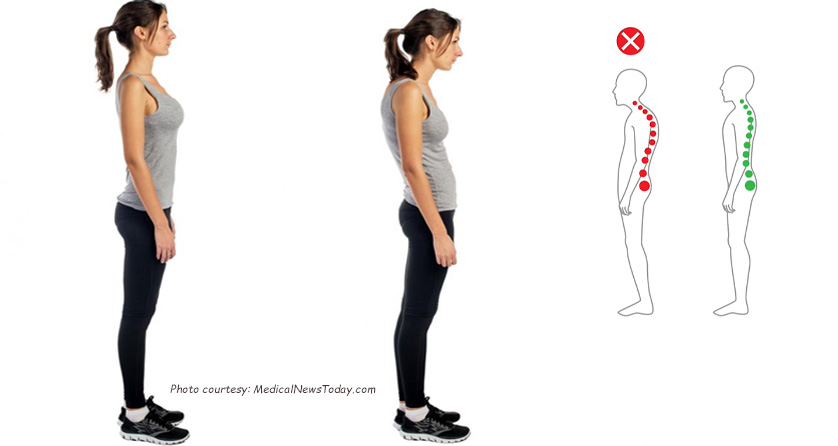Sure, goat yoga is Instagrammable and quirky, but there’s something both beautiful and transformative about hanging from the sky, ensconced in silk, like a butterfly emerging from your cocoon. Enter aerial yoga.
In addition to providing many physical and mental benefits and fun acrobatics, aerial yoga is quickly gaining stride as a therapeutic and accessible yoga option.
What is aerial yoga?
Aerial yoga combines traditional asana (the physical postures of yoga) and yoga philosophies with the aerial arts. Silk fabrics and/or ropes are hung from above to aid practitioners in forming shapes.
You can be fully supported by the silks — even lying down entirely, like in a hammock — or wrap the silks around particular body parts, keeping other parts on the floor.
Hanging fully or suspending individual body parts is believed to create traction and open your body more gently and intuitively than when you’re on the floor. The silks and ropes can also be helpful for balance.
While many aerial yoga classes have an acrobatic element, a growing number of classes and teachers are also using the aerial silks much more therapeutically.
Jo Stewart, the co-owner of Garden of Yoga, a Melbourne-based studio offering a wide range of aerial yoga classes, is a huge proponent of using the aerial silks in a more therapeutic way.
As she says, “the versatility and support of the fabric allow people to access new movements. It can also reduce the load on wrists and knees, which can sometimes limit mobility in a floor-based practice.”
For people with knee issues, getting to the floor can be challenging. But, Stewart says, “the aerial fabric essentially brings the floor up to them.”
The history of aerial yoga
The practice of yoga with props is largely credited to B.K.S. Iyengar (1918–2014), who developed the Iyengar type of yoga.
In addition to using the blocks, straps, blankets, and rope walls you may see at many studios, Iyengar would hang his students from the ceiling in yoga swings (1).
The original swings were not like the colorful silk hammocks we see today. They were often made solely of ropes and would be padded with yoga mats or blankets.
Antigravity yoga, as it was originally called, began to gain traction in the late 1990s. The first yoga swing, a collection of silk harnesses connected to handles and foot holdings, was purportedly created in the U.K. in 2001 (1).
The yoga hammock — which is one long piece of fabric — and the style name “aerial yoga” started appearing around 2011. Today, aerial yoga studios and aerial yoga-trained teachers can be found around the globe.
SUMMARY: Aerial yoga combines aerial arts with yogic philosophy and postures.
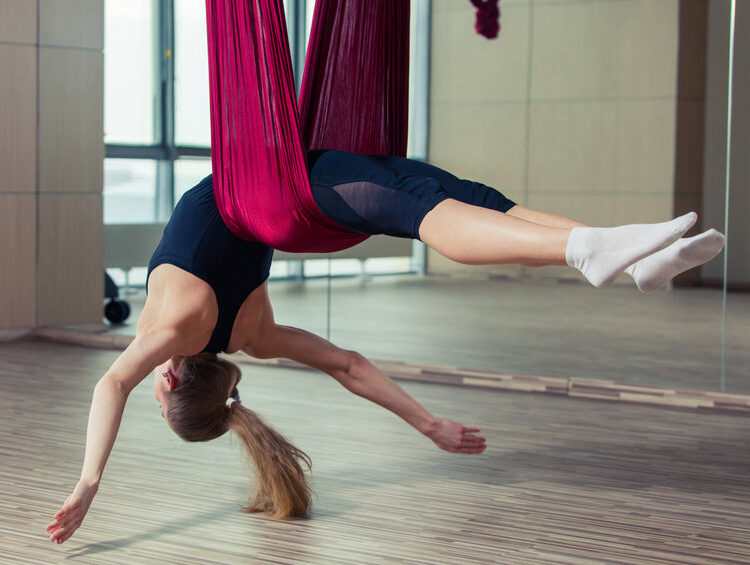
The benefits of aerial yoga
A combination of the arts and athletics, aerial yoga offers several physical and psychological benefits:
- Improved flexibility, stability, and balance. A 2019 study observed that aerial athletes have exceptional flexibility, balance, and strength. https://www.ncbi.nlm.nih.gov/labs/pmc/articles/PMC7739357/
- Traction and joint decompression. Hanging upside down and inverting are said to decompress the joints, which can compress over time due to gravity and age.
- Reduced risk factors for heart disease. While research on this style of yoga is limited, the most-cited study, conducted in 2016 by the American Council on Exercise (ACE), found significant reduction in the risk factors associated with cardiovascular heart disease.
- Low to moderate intensity. The same ACE-commissioned study found that 50 minutes of aerial yoga can burn upwards of 300 calories, making it a form of low to moderate intensity exercise.
- Improved mental health. A small study noted significant improvements in depression and stress levels when people practiced aerial arts for the love of movement. This seems to bode particularly well for aerial yoga, which applies yogic philosophies and is often less competitive and more accessible than a circus-based or formal acrobatics class.
An important disclaimer
Aerial yoga is not recommended for people who are pregnant or for whom hanging upside down is not medically advised.
This includes, but is not limited to, people with eye conditions such as cataracts or detached retina, as well as people with unregulated blood pressure.
Check with a healthcare professional before signing up for your first class.
Can you do aerial yoga at home?
Believe it or not, yes — and without having to renovate your entire living room.
Lori Salomon has been teaching Aerial Yoga Play for more than 6 years in the Bay Area. In addition to teaching in the studio, she sees a number of private clients for in-home sessions.
She finds that, if needed, the overall experience tends to be less intimidating when people learn one-on-one.
Some swings or ropes can be connected to metal framing, allowing you to fly either inside or outside.
You can also set up your silks or ropes around sturdy support beams, such as tree branches or exposed front porch beams, similarly to the way you’d traditionally hang a hammock.
Some veteran aerialists have ropes and/or aerial silks installed directly into their ceilings. Salomon’s living room is her “playground,” with three different types of yoga swings.
Always make sure to double-check your setups before flying, because attachments can loosen with time.
Equipment needed
If you’re attending an aerial class in a studio, especially if the studio is aerial-focused, you really need only your body.
Wearing well-fitted activewear with decent coverage is recommended because the ropes and silks can rub against your skin. The less obstruction and direct skin contact, the better. Some classes offer towels to help with cushioning, but you can also always bring your own.
If you prefer to fly at home, here are some suggested links to find the best aerial contraption for you. Please note, some of these are sold separately from their ceiling hooks, stands, and mounts:
Gravotonics Yoga Swing. Created in 2003 and often cited as the first of its kind, this all-in-one swing claims to be one of the most versatile and accessible options on the market.
Yoga Trapeze by Yoga Body. These are not unlike yoga swings in functionality, but Yoga Body has trademarked the term “yoga trapeze.”
Uplift Yoga. This site offers a wide variety of aerial yoga gear, including yoga hammocks, silks (individual swaths of fabric), hoops, and bungees.
AYRX Yoga Swing. Salomon jokes that these swings, developed by Aerial Yoga Play founder Jen Healy, are like the Tesla of yoga swings. You can buy individual swings or the deluxe package, which includes attachments such as leg loops and carabiners. The AYP site also offers online trainings in the method.
SUMMARY
You can fly at home or in-studio, but wherever you choose to play, wear well-fitted clothing that covers your body to prevent chafing!
How to find an aerial yoga class near you
Google is your best friend when it comes to finding yoga classes nearby. Simply enter “aerial yoga near me” or “aerial yoga therapeutics near me” in the search box.
Also be sure to ask your local yoga studios if they offer aerial classes or if they know instructors who may teach the style privately. Many local studios offer one-off classes or specialty workshops.
SUMMARY
If you can’t find an aerial studio nearby, some local studios offer specialty aerial yoga courses or workshops. Make sure to get your doctor’s approval before trying a class.
What to expect from your first aerial class
Stewart says to expect a lot of laughter and to be ready to surprise yourself.
Prior yoga knowledge is not necessary.
Stewart suggests that even those with some yoga experience start with a beginner-level aerial yoga class or a more restorative-style class. This enables people to get comfortable with moving with the fabric before attempting more complex sequences.
It’s not uncommon to feel a bit of motion sickness from the movement in your first class, especially when coming back upright after hanging upside down.
Please make sure to tell your teacher if you have any underlying health conditions. Stewart suggests seeking out one-on-one courses or teachers trained in more therapeutic-style aerial yoga if you are managing acute or chronic medical conditions.
SUMMARY
Expect laughter, surprise, and possibly some dizziness.
Tips for beginners
- Listen to your body. If something doesn’t feel right, take a break or ask for assistance.
- Communicate. The rope and sling placement can be key during this practice, but only you know how something feels. If something is painful or uncomfortable, ask your teacher to help you find the perfect placement.
- Go easy. Salomon reminds students that “a little goes a long way” in aerial yoga and to start slowly as you get used to the style.
Trust. Trust the contraption, trust your teacher, but most importantly, trust yourself. - Have fun. Some of the shapes may feel out of reach at first, especially if you’re brand-new to yoga. You may get tangled, and you may get confused, but if you remember that you’re there to have fun, none of that will matter!
The bottom line
Many styles of yoga are available these days, each with its own unique benefits. Aerial yoga is not just fun for those who are more acrobatic — with therapeutic and restorative-style classes, it can be incredibly accessible too.
Article by:
Sarah Ezrin on February 10, 2022; Medically reviewed by Courtney Sullivan, Certified Yoga Instructor
Sarah Ezrin is a writer, yoga teacher, and motivator. She is based in San Francisco where she lives with her husband and their dog. For more information on Sarah please visit her website or connect with her on Facebook, Instagram, or Twitter.

